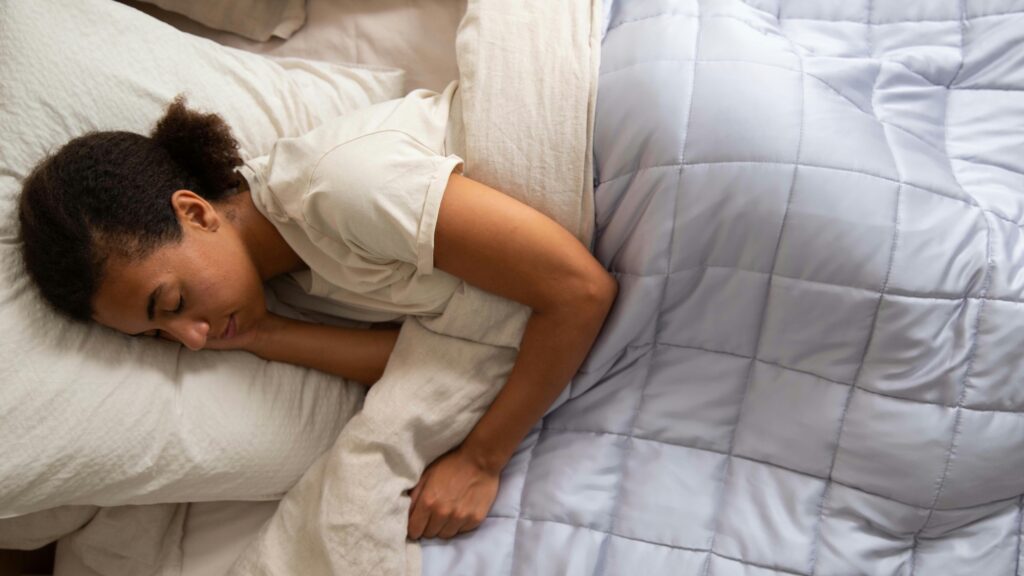Men are from Mars and women are from Venus certainly rings true when it comes to sleep.
Women’s sleep is vastly different from men’s, which stems from circadian biology, hormonal cycles, and inherent differences in sleep architecture.
Women experience deeper sleep in general. But an earlier sleep/wake cycle, hormonal fluctuations that put pressure on sleep quality, and the pressures of balancing work and family can make for a challenging picture. And one that can affect health and well-being.
If you’re looking to understand the relationship between the way men and women sleep, read our full in-depth guide backed by science.
Women sleep longer, but feel worse
Women tend to sleep longer and get more deep sleep than men, but they also report worse sleep quality and are twice as likely to suffer from insomnia, according to a recent review led by Dr. Sarah L. Chellappa from the University of Southampton (Lok et al., 2024).
The study found that women consistently rate their sleep quality lower than men and experience greater fluctuations in sleep quality across the menstrual cycle. These patterns are closely tied to hormonal changes, mood shifts, and increased prevalence of anxiety and depression, both of which are twice as common in women (Andersen et al., 2023).
Read next: Ultrahuman Cycle and Ovulation PowerPlug explained
Women also face higher rates of restless legs syndrome (25–50% higher risk) and are up to four times more likely to develop sleep-related eating disorder, a condition that causes repeated nighttime eating episodes (Lee, 2024).
By contrast, men are three times more likely to be diagnosed with obstructive sleep apnoea (OSA) – though the condition presents differently in women, which may lead to underdiagnosis. Notably, OSA is associated with a higher risk of heart failure in women, but not in men (Lok et al., 2024).
How hormones shape women’s sleep

Sleep architecture isn’t static – it shifts in response to hormonal changes, especially in women.
From puberty, women’s sleep changes dramatically thanks to the two key hormones in the cycle: progesterone and estrogen. Each play distinct yet interconnected roles in shaping the depth and structure of sleep (Andersen et al., 2023).
Progesterone has a sedative-like effect on the brain. It enhances slow-wave sleep (N3), the deepest and most restorative phase.
This deepening effect is particularly noticeable during the luteal phase of the menstrual cycle, when progesterone peaks. It may explain why some women report feeling sleepier or more sluggish in the second half of their cycle.
More: Four stages of the menstrual cycle explained
Estrogen, on the other hand, influences REM sleep stability. It modulates serotonin and acetylcholine, neurotransmitters that help regulate REM onset and duration. High estrogen levels – such as those seen pre-ovulation or in pregnancy – can increase REM density and improve overall sleep continuity.
But when estrogen drops sharply – as it does before menstruation or during perimenopause – REM fragmentation and night wakings become more common.
These cyclical hormonal shifts create variable sleep patterns across the menstrual cycle, pregnancy, and into menopause.
In menopause, when both estrogen and progesterone decline significantly, women often experience increased sleep latency, reduced deep sleep. This, as well as symptoms such as hot flashes, means more frequent awakenings, contributing to the well-documented rise in insomnia during this phase.
Women and circadian rhythm

Biological clocks aren’t one-size-fits-all, and for many women, their internal timekeeping runs slightly earlier than men’s.
On average, women’s circadian rhythms phase-advance by around 30 to 60 minutes earlier than men’s. This means they tend to have a morning ‘chronotype’, which prefers earlier sleep and wake times (Lok et al., 2024).
The mismatch between this internal timing and the demands of modern life (early work schedules, late-night childcare, or juggling work and family) creates “social jet lag.” This occurs when the body’s natural rhythms are out of sync with our actual real-life cycles.
For women who are early chronotypes, waking up for early commitments may not be the issue. It’s the extended wakefulness into evening hours, often required by family or work obligations, that leads to cumulative strain.
Compounding the issue is that melatonin onset shifts across the cycle. It’s often delayed in the luteal phase, which can cause evening wakefulness. If the body’s core clock is already misaligned due to work, family, and life commitments, it can exacerbate poor sleep, recovery, and sleep debt (Andersen et al., 2023).
The bottom line: timing matters. Aligning sleep-wake schedules with biological rhythms – with a strong and consistent sleep/wake pattern – could be a powerful lever for feeling rested, reducing stress, and improving long-term health.
Conclusion
Women’s sleep is distinctly different from men’s, with higher levels of deep sleep and an earlier sleep/wake cycle. But an earlier chronotype, coupled with changes in sleep throughout the menstrual cycle and the pressures of balancing life and family, can cause chronic circadian misalignment – otherwise known as social jet lag.
Social jet lag is linked to a host of poorer health outcomes over time, so it’s essential that women build a consistent sleep/wake cycle and understand the fluctuations of the cycle to maximise sleep quality.
Citations
Lok R, Qian J, Chellappa SL. (2024). Sex differences in sleep, circadian rhythms, and metabolism.
Lee HW. (2024). Sex/Gender Differences in Sleep Physiology and Sleep Disorders.
Andersen ML, Hachul H, et al. (2023). Sleep in women: hormonal influences, sex differences and health implications.
University of Southampton. (2024, April 10). Sex differences in sleep may explain why women experience more sleep problems.







